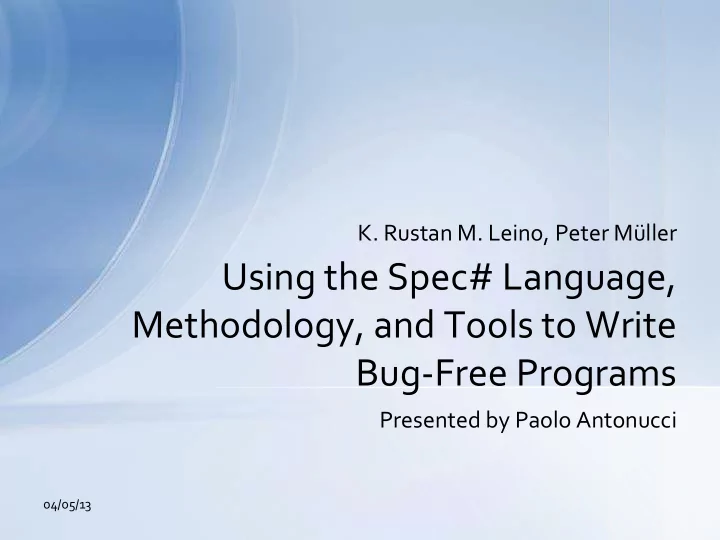

K. Rustan M. Leino, Peter Müller Using the Spec# Language, Methodology, and Tools to Write Bug-Free Programs Presented by Paolo Antonucci 04/05/13
About this paper This paper is more similar to a practical tutorial than a research paper. “ It is specifically not a goal of this tutorial to justify the Spec# methodology, only to explain how it is used. ” Focus on the language, in the status it was when the paper was published. 2
What is Spec#? Spec# is a research language that extends C# 2.0 with new constructs and features. In particular it features program specifications that are enforced both statically and dynamically. A verifier runs at compile time and attempts to prove the program correct. Verification is modular. 3
The Spec# methodology Spec# imposes a methodology (programming discipline). Following this will lead to well specified and easily verifiable programs. Unfortunately it is very easy to fall outside the boundaries. It is much easier to verify programs if they are designed according to this methodology from the start. 4
Outline • Introduction We are here! • Quick tour into Spec# • Demo • Final discussion 5
Class invariants public class Exam { Class invariant: must always hold when the private int ExGrade = 100; object is consistent private DateTime ExDate; invariant ValidGrade(ExGrade); [Pure] static bool ValidGrade(int grade) ensures result == ((grade % 25 == 0) && 100 <= grade && grade <= 600); Pure function { return (grade % 25 == 0) && 100 <= grade && grade <= 600; } } Pure functions promise to return values with no side effect. This makes it possible to use them in program specifications. 6
Class invariants Sometimes it is necessary to temporarily break an object invariant. This is done by “exposing” the object with the expose construct. expose (this) { // Break the invariant // Restore the invariant } The verifier will attempt to prove that at the end of the expose block the invariant is restored. 7
Method contracts public void setGrade(int grade) Methods are only requires ValidGrade(grade); allowed to modify fields ensures ExGrade == grade; declared here modifies this.ExGrade; { ExGrade = grade; } Contracts are checked both statically and dynamically. Methods are also checked to maintain class invariants. The modifies clause can be omitted: in this case it is interpreted as modifies this.* . Redefined methods inherit contracts from the superclass. 8
Assertions and assumptions public void setGrade(int grade) Inline assertions are checked requires ValidGrade(grade); by the program verifier. They ensures ExGrade == grade; modifies this.ExGrade; are redundant in principle. { ExGrade = grade; assert 400 <= ExGrade; } public void setGrade(int grade) Assumptions are taken on requires ValidGrade(grade); faith by the program verifier. ensures ExGrade == grade; modifies this.ExGrade; They trade static checking for { flexibility. ExGrade = grade; assume 400 <= ExGrade; } BOTH are checked at runtime. 9
Non-null types All variables of non-primitive types can be declared either as non-null or as possibly null. An exclamation mark (bang!) declares a non-null type. A question mark (uh?) declares a possibly-null type. Dereferencing a possibly-null pointer is only allowed if static dataflow analysis can prove that it cannot be null at that point. public static void pippo(string! foo, string? bar) { Console.WriteLine(foo.Length); if (bar == null) return; Console.WriteLine(bar.Length); } 10
Demo DEMO 11
Conclusion – how it feels Verification warnings feel like a natural extension of classic compiler warnings. The verifier seems to be reasonably “smart”. Nevertheless, Spec# is indeed complex. Not suitable for the average programmer. This complexity feels usually elegant, but sometimes some innocuous features can be surprisingly awkward. 12
Conclusion – current status Undoubtedly still a research language. • Almost no documentation • Development tools somewhat buggy • Sometimes unexpected behavior (e.g. cannot prove anything about doubles) In the future some features could make it to C#. • This was already the case for Code Contracts Sadly, development doesn’t seem to be active. 13
References • Spec# home page http://research.microsoft.com/en-us/projects/specsharp/ • Spec# CodePlex repository http://specsharp.codeplex.com/ • Try Spec# online http://rise4fun.com/SpecSharp • Many research papers related to Spec#, more references in the Spec# home page and in this paper 14
Question time Questions? 15
Bonus slide Object ownership – recall Spec# supports object topology/ownership. An object can, for example, own other objects used for the internal representation of its data. This is encoded with the [Rep] attribute in the code. public class StudentCurriculum { [Rep] Thesis? MasterThesis; } Object owners can also be set manually and specified in contracts. 16
Bonus slide Object ownership – recall As an informal rule, an object can only be modified with the “permission” of its owner. This makes it possible for object invariants to rely on [Rep] owned objects. 17
Bonus slide Object ownership and invariants – recall Sometimes it is necessarily to temporarily break an object invariant. This is done by “exposing” the object with the expose construct. expose (this) { // Break the invariant // Restore the invariant } 18
Bonus slide Object ownership and invariants – recall As object invariants can refer to owned [Rep] objects, any change to an object can potentially break the invariant of its owner. For this reason, non-pure methods can only be called on an object after exposing its owner. public void setThesisTitle(string title) { expose (this) { // This is necessary! MasterThesis.setTitle(title); } } This was just a quick recall, there is much more about this. 19
Recommend
More recommend